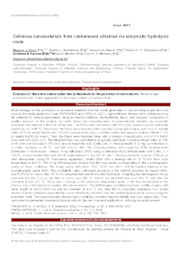Cellulose nanomaterials from rubberwood obtained via enzymatic hydrolysis route.
Cellulose nanomaterials from rubberwood obtained via enzymatic hydrolysis route.
Author(s): SILVA, M. J.; BONDANCIA, T. J.; AGUIAR, J. de; GONÇALVES, E. C. P.; FARINAS, C. S.; MARTINS, M. A.; MATTOSO, L. H. C.
Summary: Novel strategy for the production of advanced materials from the waste generated in natural rubber exploration can improve the whole production chain(PARASHAR and CHAWLA, 2021). Lignocellulosic biomass from rubberwood has the potential for several applications, being formed by cellulose, hemicellulose, lignin, and inorganic compounds in smaller amounts. In this context, this work shows the characterization of nanomaterials obtained via enzymatic hydrolysis from bleached fibers of rubber tree. The fibers were mercerized with 5% (w/w) aqueous sodium hydroxide solution for 2h at 80 °C. Afterwards, the fibers were bleached with a solution composed of equal parts (v/v) of acetate buffer (27% by weight NaOH and 7.5% (v/v) glacial acetic acid, in distilled water) and aqueous sodium chlorite (1.7% by weight NaClO2 in water). Then, the fibers were bleached twice with a solution of equal parts (v/v) of 4% NaOH (w/w) and 24% H2O2 (v/v). The bleached fiber was submitted to enzymatic hydrolysis in sodium citrate buffer (0.1 M, pH 5), with a solids load of 15% (w/v) and an enzymatic load (Cellic Ctec 3 Novozymes®) of 10 mg / g of biomass in a shaker incubator at 50 °C. and 200 rpm for 48h. The characterizations were made by AFM measurements (Dimension V microscope - Veeco); X-ray diffraction (XRD) using a Shimadzu 6000 diffractometer with CuK ( = 1,54 Å), at room temperature and with 2 angle between 5 and 40° (1° min-1); thermogravimetric analysis (TGA) in an inert atmosphere, using TA Instruments equipment, model Q500 with a heating rate of 10 °C/min from room temperature to 600 °C. The X-ray diffractograms showed that the main peaks corresponding to the crystallographic planes of Type I cellulose. The Bragg angles (2) were: 16.0°, 22.4° and 34.6°, with the highest intensity in the crystallographic plane (002). The crystallinity index, calculated according to the method proposed by Segal (1959), was 57.8% for in natura fiber, 75.1% for bleached fiber and 80.8% after hydrolysis. Analyzing the thermograms, it was observed that the Tonset of the fiber in natura was 289 °C, that of the bleached fiber was 292 °C and after the hydrolysis it was 327 °C. There was a change in the maximum degradation peak, in the final temperature of the process and in the amount of residue after the treatment. The AFM images exhibited structures rod-like shapes, with mean length of 349.9±169.6 nm and the diameter of 4.0±1.7 nm, after 48h to enzymatic hydrolysis. Our results showed that the obtained nanomaterials can be effectively extracted from the studied lignocellulosic source using the enzymatic route. The nanostructures showed high crystallinity, excellent thermal stability and high aspect ratio. Thus, nanomaterials presented important characteristics for the use in several applications, including as reinforcement.
Publication year: 2022
Types of publication: Abstract in annals or event proceedings
Unit: Embrapa Instrumentation
Observation
Some of Embrapa's publications are published as ePub files. To read them, use or download one of the following free software options to your computer or mobile device. Android: Google Play Books; IOS: iBooks; Windows and Linux: Calibre.
Access other publications
Access the Agricultural Research Database (BDPA) to consult Embrapa's full library collection and records.
Visit Embrapa Bookstore to purchase books and other publications sold by Embrapa.

